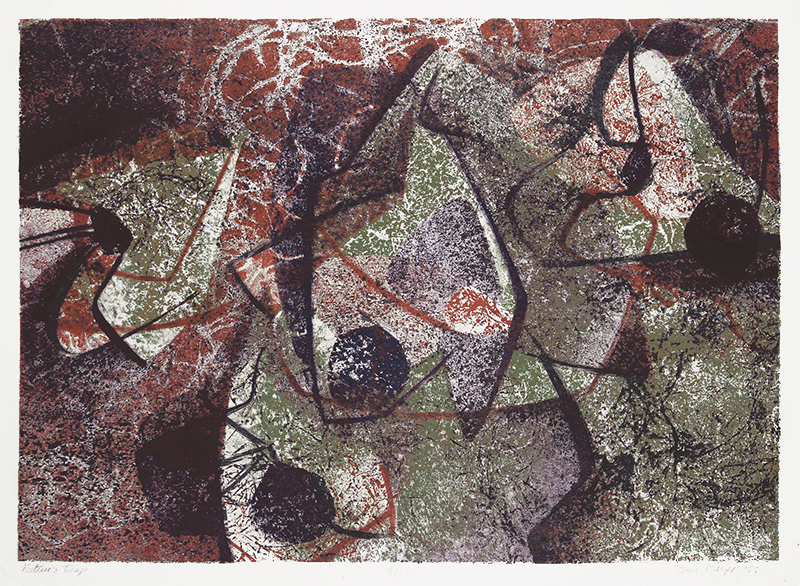
19th, 20th & 21st Century Fine Prints
707-546-7352 · fax 707-546-7924 · web: www.annexgalleries.com · email: artannex@aol.com
Nature's Trap by Doris Meyer Chatham

Nature's Trap
Doris Meyer Chatham
Nature's Trap
Doris Meyer Chatham
1923 - 2015 (biography)A vibrant composition in lithograph exemplifying mid-century American Abstract Expressionism. The image is developed using a collection of delicate, line, shapes and colors arranged to add substance and depth and the viewer is led through an organic complex composition. Chatham's "Nature's Trap" appears at once spontaneous and intentional, and her use of transparent inks provides luminesence.
An Abstract Expressionist color lithograph done by Doris Meyer Chatham after studying printmaking in Paris in the 1950s. Meyer traveled to France to study printmaking with Stanley William Hayter, who had returned to Paris and re-opened Atelier 17 in 1950. She also studied independently with Atelier 17 printmaker Kaiko Moti, who had been pivotal in evolving the editioning of the simultaneous color printing (also called "viscosity printing") methods that were being experimented with at the Atelier. She continued to correspond with Hayter and Moti throughout the fifties and sixties.
Doris Meyer Chatham (née Doris Hoag Clark) was born in Toronto, Canada on 10 January 1923. She earned her BFA degree from the Rice Institute (now known as Rice University) in Houston, Texas. On 19 February 1945, she married German-born Professor Heinrich Meyer, (also known by the nom de plumes Robert O. Barlow, H. K. Houston Meyer, and Hugo Cartesius), a linguist and Goethe scholar who taught at Rice Institute. In 1938 Meyer wrote a letter to then German Chancellor Adolf Hitler and requested an audience in which he wanted to explain how the Nazis' anti-Jewish campaign was affecting American feelings, the offer was refused but Meyer, who had been naturalized in 1935, was taken into custody by the FBI on March 8, 1943, and turned over to the Immigration and Naturalization Department. He spent the next three months in a concentration camp in Kenedy, Texas. Meyer's case was the first de-naturalization case in the Southern District of Texas and the first civil action filed by the U.S. attorney's office to revoke the citizenship rights of Houstonians born in Germany. Upon appeal Meyer's citizenship was reversed in April 1944 by the Circuit Court of Appeals in New Orleans since the court believed that a naturalized citizen had the same freedom of thinking and speaking as a native citizen.
In 1945, the Meyers moved to Emmaus, Pennsylvania to open a cooperative farming community with controversial organic health advocate Jerome Irving Rodale. Doris helped edit Rodale’s Organic Farming and Gardening and Prevention magazines and assisted with planting his first organic garden, one of the first in the United States.
After Doris and Heinrich Meyer were divorced in early 1955, she started driving to parts unknown and ended up in the Pacific Northwest. In Seattle, she studied printmaking at the University of Washington with Glen Alps who taught her lithography and collagraphy. After graduation, she landed a job teaching art at Everett Junior College in Washington. Her style was distinctly Abstract at this time and she worked in lithography, two facts that went against the grain during such a male-dominated time in 20th century Modernism.
Doris moved to Marin County, California and began teaching printmaking at the College of Marin where she met and later married the painter Russell Chatham and they settled in Marshall, California. When their marriage failed, Meyer Chatham returned to the Pacific Northwest. She experimented with the gestural composition, developed at Atelier 17 but using screenprinting and lithography rather than intaglio. Most of her color prints, such as Nature's Trap, were done as experiments and were not printed in large editions, in this case only 27 impressions.
Doris Hoag Clark Meyer Chatham died on 8 June 2015 in Portland, Oregon.
